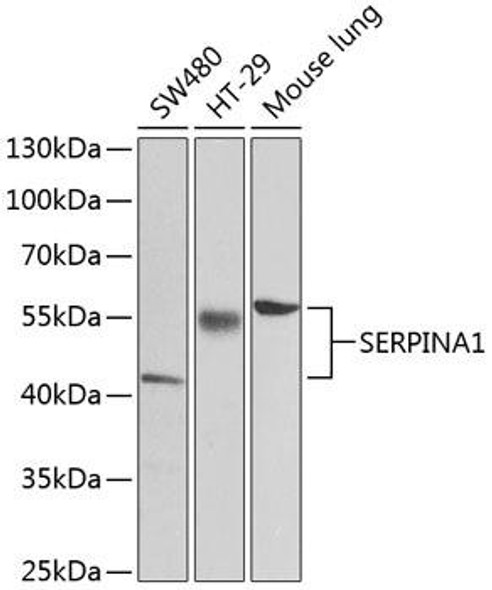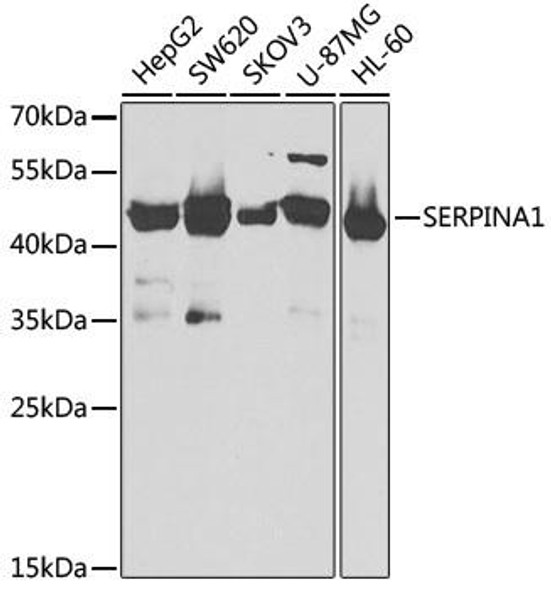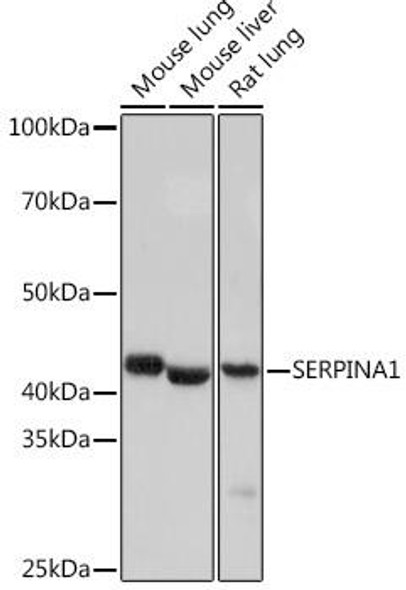Description
Human Alpha-1-antitrypsin (SERPINA1) ELISA Kit
The Human Alpha-1-Antitrypsin (SERPINA1) ELISA Kit is specifically designed for the precise detection of alpha-1-antitrypsin levels in human serum, plasma, and cell culture supernatants. This kit is known for its high sensitivity and specificity, ensuring accurate and consistent results that are essential for various research applications.Alpha-1-antitrypsin is a critical protein that plays a key role in protecting tissues from degradation by enzymes, particularly in the lungs. Disruption of alpha-1-antitrypsin levels has been associated with various conditions, including lung diseases, liver disorders, and inflammation.
By using the Human Alpha-1-Antitrypsin ELISA Kit, researchers can gain valuable insights into the role of alpha-1-antitrypsin in disease pathology, as well as explore potential therapeutic interventions. This kit provides a reliable tool for studying alpha-1-antitrypsin levels in different biological samples, offering a comprehensive solution for investigating the function and implications of this crucial protein.
| Product Name: | Human Alpha-1-antitrypsin (SERPINA1) ELISA Kit |
| SKU: | HUEB0281 |
| Size: | 96T |
| Target: | Human Alpha-1-antitrypsin (SERPINA1) |
| Synonyms: | Alpha-1 protease inhibitor, Alpha-1-antiproteinase, Serpin A1, PRO0684, PRO2209, AAT, PI |
| Assay Type: | Sandwich |
| Detection Method: | ELISA |
| Reactivity: | Human |
| Detection Range: | 3.12-200ng/mL |
| Sensitivity: | 1.2ng/mL |
| Intra CV: | 3.7% | ||||||||||||||||||||
| Inter CV: | 5.6% | ||||||||||||||||||||
| Linearity: |
| ||||||||||||||||||||
| Recovery: |
| ||||||||||||||||||||
| Function: | Short peptide from AAT: reversible chymotrypsin inhibitor. It also inhibits elastase, but not trypsin. Its major physiological function is the protection of the lower respiratory tract against proteolytic destruction by human leukocyte elastase (HLE). |
| Uniprot: | P01009 |
| Sample Type: | Serum, plasma, tissue homogenates, cell culture supernates and other biological fluids |
| Specificity: | Natural and recombinant human Alpha-1-antitrypsin |
| Sub Unit: | The variants S and Z interact with CANX AND PDIA3. |
| Research Area: | Development Biology |
| Subcellular Location: | Short peptide from AAT Secreted Extracellular space Extracellular matrix |
| Storage: | Please see kit components below for exact storage details |
| Note: | For research use only |
| UniProt Protein Function: | Function: Inhibitor of serine proteases. Its primary target is elastase, but it also has a moderate affinity for plasmin and thrombin. Irreversibly inhibits trypsin, chymotrypsin and plasminogen activator. The aberrant form inhibits insulin-induced NO synthesis in platelets, decreases coagulation time and has proteolytic activity against insulin and plasmin. Ref.17 Ref.18 Ref.24Short peptide from AAT (SPAAT) is a reversible chymotrypsin inhibitor. It also inhibits elastase, but not trypsin. Its major physiological function is the protection of the lower respiratory tract against proteolytic destruction by human leukocyte elastase (HLE). Ref.17 Ref.18 Ref.24 |
| UniProt Protein Details: | Subcellular location: Secreted Ref.24. Short peptide from AAT: Secreted extracellular space extracellular matrix Ref.24. Tissue specificity: Plasma. Domain: The reactive center loop (RCL) extends out from the body of the protein and directs binding to the target protease. The protease cleaves the serpin at the reactive site within the RCL, establishing a covalent linkage between the carboxyl group of the serpin reactive site and the serine hydroxyl of the protease. The resulting inactive serpin-protease complex is highly stable. Post-translational modification: Several isomers are observed, resulting from the combination of different N-linked glycan structures and mature N-terminus. N-linked glycan at Asn-107 is alternatively di-antennary, tri-antennary or tetra-antennary, whereas glycan at Asn-70 is di-antennary with trace amounts of tri-antennary, and glycan at Asn-271 is exclusively di-antennary. The structure of the antennas is Neu5Ac(alpha1-6)Gal(beta1-4)GlcNAc attached to the core structure Man(alpha1-6)[Man(alpha1-3)]Man(beta1-4)GlcNAc(beta1-4)GlcNAc. Some antennas are fucosylated, which forms a Lewis-X determinant.Proteolytic processing may yield the truncated form that ranges from Asp-30 to Lys-418. Polymorphism: The sequence shown is that of the M1V allele which is the most common form of PI (44 to 49%). Other frequent alleles are: M1A 20 to 23%; M2 10 to 11%; M3 14 to 19%. Involvement in Disease: Defects in SERPINA1 are the cause of alpha-1-antitrypsin deficiency (A1ATD) [ MIM:613490]. A disorder whose most common manifestation is emphysema, which becomes evident by the third to fourth decade. A less common manifestation of the deficiency is liver disease, which occurs in children and adults, and may result in cirrhosis and liver failure. Environmental factors, particularly cigarette smoking, greatly increase the risk of emphysema at an earlier age. Ref.58 Ref.60 Ref.62 Miscellaneous: The aberrant form is found in the plasma of chronic smokers, and persists after smoking is ceased. It can still be found ten years after smoking has ceased. Sequence similarities: Belongs to the serpin family. Sequence caution: The sequence CAD62334.1 differs from that shown. Reason: Erroneous initiation. Translation N-terminally shortened.The sequence CAD62585.1 differs from that shown. Reason: Erroneous initiation. Translation N-terminally shortened. |
| NCBI Summary: | The protein encoded by this gene is secreted and is a serine protease inhibitor whose targets include elastase, plasmin, thrombin, trypsin, chymotrypsin, and plasminogen activator. Defects in this gene can cause emphysema or liver disease. Several transcript variants encoding the same protein have been found for this gene. [provided by RefSeq] |
| UniProt Code: | P01009 |
| NCBI GenInfo Identifier: | 1703025 |
| NCBI Gene ID: | 5265 |
| NCBI Accession: | P01009.3 |
| UniProt Secondary Accession: | P01009,Q0PVP5, Q13672, Q53XB8, Q5U0M1, Q7M4R2, Q86U18 Q86U19, Q96BF9, Q96ES1, A6PX14, B2RDQ8, |
| UniProt Related Accession: | P01009,Q13747,Q2L9S7,Q3I0J7,Q9P173 |
| Molecular Weight: | 46,737 Da |
| NCBI Full Name: | Alpha-1-antitrypsin |
| NCBI Synonym Full Names: | serpin peptidase inhibitor, clade A (alpha-1 antiproteinase, antitrypsin), member 1 |
| NCBI Official Symbol: | SERPINA1 |
| NCBI Official Synonym Symbols: | PI; A1A; AAT; PI1; A1AT; MGC9222; PRO2275; MGC23330; alpha1AT |
| NCBI Protein Information: | alpha-1-antitrypsin; serpin A1; OTTHUMP00000197150; OTTHUMP00000197151; OTTHUMP00000197152; OTTHUMP00000197153; OTTHUMP00000197154; alpha-1-antiproteinase; alpha-1 protease inhibitor; protease inhibitor 1 (anti-elastase), alpha-1-antitrypsin; serine (or cysteine) proteinase inhibitor, clade A, member 1 |
| UniProt Protein Name: | Alpha-1-antitrypsin |
| UniProt Synonym Protein Names: | Alpha-1 protease inhibitor; Alpha-1-antiproteinase; Serpin A1 |
| Protein Family: | Alpha-1-antitrypsin |
| UniProt Gene Name: | SERPINA1 |
| UniProt Entry Name: | A1AT_HUMAN |
| Component | Quantity (96 Assays) | Storage |
| ELISA Microplate (Dismountable) | 8×12 strips | -20°C |
| Lyophilized Standard | 2 | -20°C |
| Sample Diluent | 20ml | -20°C |
| Assay Diluent A | 10mL | -20°C |
| Assay Diluent B | 10mL | -20°C |
| Detection Reagent A | 120µL | -20°C |
| Detection Reagent B | 120µL | -20°C |
| Wash Buffer | 30mL | 4°C |
| Substrate | 10mL | 4°C |
| Stop Solution | 10mL | 4°C |
| Plate Sealer | 5 | - |
Other materials and equipment required:
- Microplate reader with 450 nm wavelength filter
- Multichannel Pipette, Pipette, microcentrifuge tubes and disposable pipette tips
- Incubator
- Deionized or distilled water
- Absorbent paper
- Buffer resevoir
*Note: The below protocol is a sample protocol. Protocols are specific to each batch/lot. For the correct instructions please follow the protocol included in your kit.
Allow all reagents to reach room temperature (Please do not dissolve the reagents at 37°C directly). All the reagents should be mixed thoroughly by gently swirling before pipetting. Avoid foaming. Keep appropriate numbers of strips for 1 experiment and remove extra strips from microtiter plate. Removed strips should be resealed and stored at -20°C until the kits expiry date. Prepare all reagents, working standards and samples as directed in the previous sections. Please predict the concentration before assaying. If values for these are not within the range of the standard curve, users must determine the optimal sample dilutions for their experiments. We recommend running all samples in duplicate.
| Step | |
| 1. | Add Sample: Add 100µL of Standard, Blank, or Sample per well. The blank well is added with Sample diluent. Solutions are added to the bottom of micro ELISA plate well, avoid inside wall touching and foaming as possible. Mix it gently. Cover the plate with sealer we provided. Incubate for 120 minutes at 37°C. |
| 2. | Remove the liquid from each well, don't wash. Add 100µL of Detection Reagent A working solution to each well. Cover with the Plate sealer. Gently tap the plate to ensure thorough mixing. Incubate for 1 hour at 37°C. Note: if Detection Reagent A appears cloudy warm to room temperature until solution is uniform. |
| 3. | Aspirate each well and wash, repeating the process three times. Wash by filling each well with Wash Buffer (approximately 400µL) (a squirt bottle, multi-channel pipette,manifold dispenser or automated washer are needed). Complete removal of liquid at each step is essential. After the last wash, completely remove remaining Wash Buffer by aspirating or decanting. Invert the plate and pat it against thick clean absorbent paper. |
| 4. | Add 100µL of Detection Reagent B working solution to each well. Cover with the Plate sealer. Incubate for 60 minutes at 37°C. |
| 5. | Repeat the wash process for five times as conducted in step 3. |
| 6. | Add 90µL of Substrate Solution to each well. Cover with a new Plate sealer and incubate for 10-20 minutes at 37°C. Protect the plate from light. The reaction time can be shortened or extended according to the actual color change, but this should not exceed more than 30 minutes. When apparent gradient appears in standard wells, user should terminatethe reaction. |
| 7. | Add 50µL of Stop Solution to each well. If color change does not appear uniform, gently tap the plate to ensure thorough mixing. |
| 8. | Determine the optical density (OD value) of each well at once, using a micro-plate reader set to 450 nm. User should open the micro-plate reader in advance, preheat the instrument, and set the testing parameters. |
| 9. | After experiment, store all reagents according to the specified storage temperature respectively until their expiry. |
When carrying out an ELISA assay it is important to prepare your samples in order to achieve the best possible results. Below we have a list of procedures for the preparation of samples for different sample types.
| Sample Type | Protocol |
| Serum | If using serum separator tubes, allow samples to clot for 30 minutes at room temperature. Centrifuge for 10 minutes at 1,000x g. Collect the serum fraction and assay promptly or aliquot and store the samples at -80°C. Avoid multiple freeze-thaw cycles. If serum separator tubes are not being used, allow samples to clot overnight at 2-8°C. Centrifuge for 10 minutes at 1,000x g. Remove serum and assay promptly or aliquot and store the samples at -80°C. Avoid multiple freeze-thaw cycles. |
| Plasma | Collect plasma using EDTA or heparin as an anticoagulant. Centrifuge samples at 4°C for 15 mins at 1000 × g within 30 mins of collection. Collect the plasma fraction and assay promptly or aliquot and store the samples at -80°C. Avoid multiple freeze-thaw cycles. Note: Over haemolysed samples are not suitable for use with this kit. |
| Urine & Cerebrospinal Fluid | Collect the urine (mid-stream) in a sterile container, centrifuge for 20 mins at 2000-3000 rpm. Remove supernatant and assay immediately. If any precipitation is detected, repeat the centrifugation step. A similar protocol can be used for cerebrospinal fluid. |
| Cell culture supernatant | Collect the cell culture media by pipette, followed by centrifugation at 4°C for 20 mins at 1500 rpm. Collect the clear supernatant and assay immediately. |
| Cell lysates | Solubilize cells in lysis buffer and allow to sit on ice for 30 minutes. Centrifuge tubes at 14,000 x g for 5 minutes to remove insoluble material. Aliquot the supernatant into a new tube and discard the remaining whole cell extract. Quantify total protein concentration using a total protein assay. Assay immediately or aliquot and store at ≤ -20 °C. |
| Tissue homogenates | The preparation of tissue homogenates will vary depending upon tissue type. Rinse tissue with 1X PBS to remove excess blood & homogenize in 20ml of 1X PBS (including protease inhibitors) and store overnight at ≤ -20°C. Two freeze-thaw cycles are required to break the cell membranes. To further disrupt the cell membranes you can sonicate the samples. Centrifuge homogenates for 5 mins at 5000xg. Remove the supernatant and assay immediately or aliquot and store at -20°C or -80°C. |
| Tissue lysates | Rinse tissue with PBS, cut into 1-2 mm pieces, and homogenize with a tissue homogenizer in PBS. Add an equal volume of RIPA buffer containing protease inhibitors and lyse tissues at room temperature for 30 minutes with gentle agitation. Centrifuge to remove debris. Quantify total protein concentration using a total protein assay. Assay immediately or aliquot and store at ≤ -20 °C. |
| Breast Milk | Collect milk samples and centrifuge at 10,000 x g for 60 min at 4°C. Aliquot the supernatant and assay. For long term use, store samples at -80°C. Minimize freeze/thaw cycles. |








